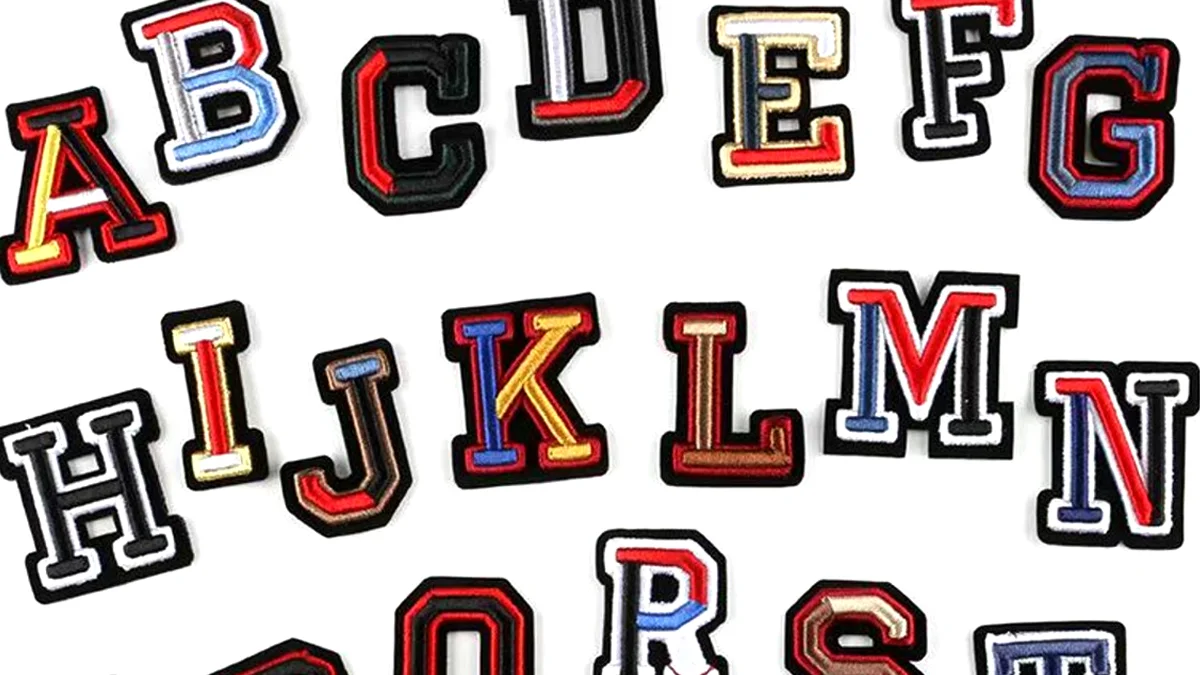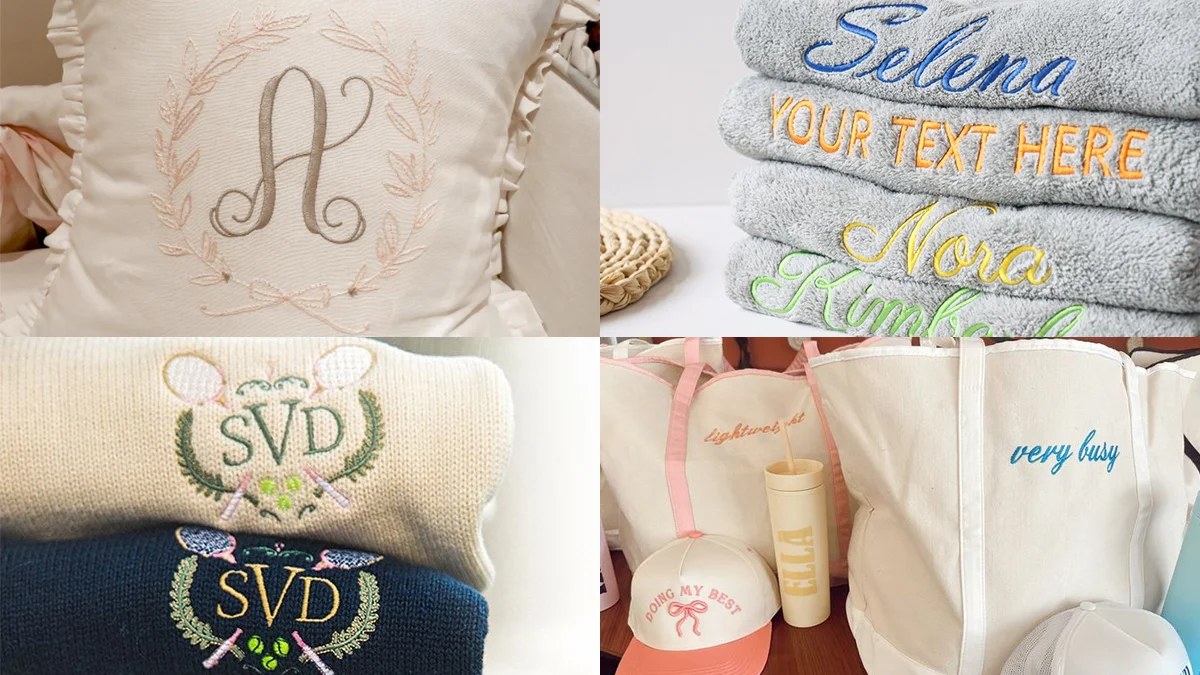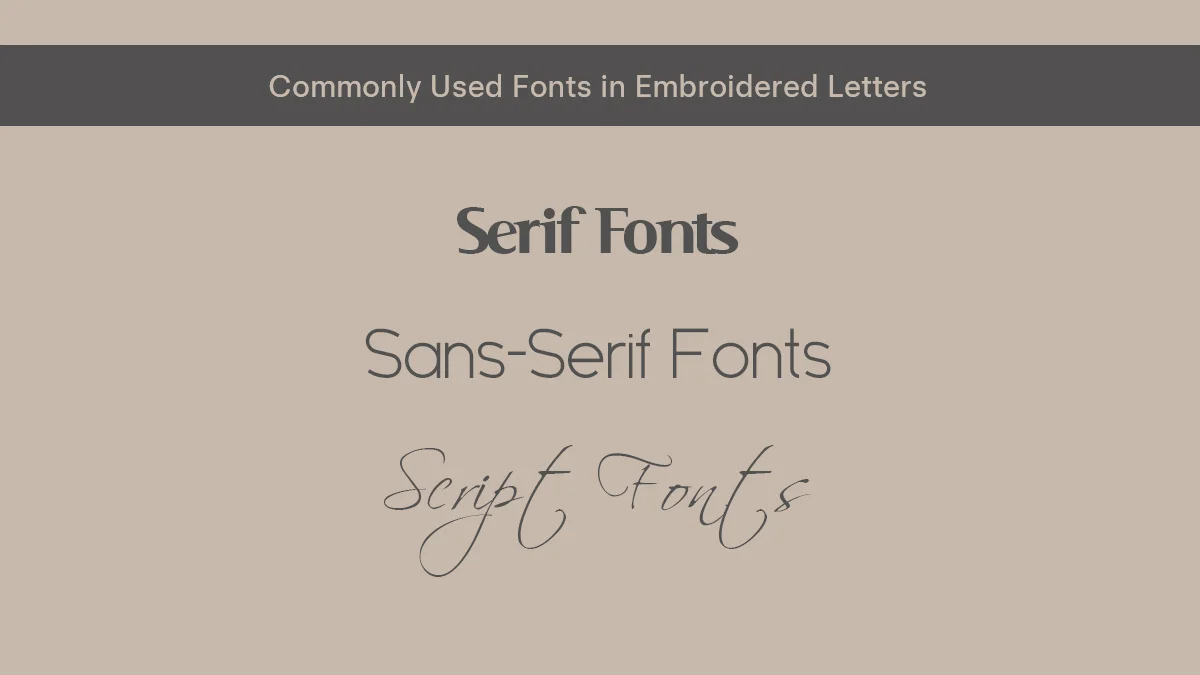
Chatting about embroidery machine bobbins
2024-11-06What you must know about blank apparel
2024-11-29EMBROIDERY TIPS
Embroidered Letters: Adding Personalization to Your Stitched Creations
POSTED ON NOVEMBER 22nd,2024 BY BAi

Have you always wanted to learn how to embroider letters? Embroidered letters can serve multiple purposes, and whether you're a beginner or an experienced embroiderer, incorporating embroidered letters into your work can take your stitching to a whole new level. In this article, we will explore the fascinating world of embroidered letters. So let's dive in together and add a personalized touch to your creations!
#1 Evolution of Embroidered Letters
#2 Modern Applications of Embroidered Letters
#3 Selection of bobbin thread
#4 Techniques for Embroidering Small Letters
#1 The Evolution of Embroidered Letters
Embroidery, as an art form, has been passed down through various cultures around the world for centuries. The use of embroidered letters can be traced back to ancient civilizations such as Ancient Egypt, where intricate patterns were sewn onto garments and textiles. In medieval Europe, embroidery became a popular form of decoration, with letters and monogram designs stitched onto clothing and household items.
In recent years, the introduction of computerized embroidery machines has revolutionized the field of letter embroidery. These embroidery machines are capable of quickly and precisely stitching complex patterns without the need for manual sewing. Computerized embroidery has opened up new possibilities for customization, allowing for more intricate and detailed letter embroidery designs.
#2 The Modern Applications of Embroidered Letters
Embroidered letters play a significant role in modern applications, serving not only as decorative elements but also for various practical purposes. Here are some of the modern applications of embroidered letters:

-1 Fashion and Apparel
Embroidered letters find widespread application in the modern fashion and apparel industry. They can be embroidered on clothing to showcase brand logos, brand names, slogans, and more. This not only adds a unique personality to the garments but also enhances brand recognition and image.
-2 Home Decor
Embroidered letters have also made their way into the realm of home decor. From decorative pillows to wall hangings, embroidered letters can add a personalized artistic touch to any living space. These embroidered letters bring warmth, individuality, and a sense of uniqueness to home interiors.
-3 Accessories
Embroidered letters have become a popular choice for accessories such as handbags, wallets, and keychains. These small and portable items provide a perfect canvas for intricate and detailed letter embroidery designs. Whether it's letter patterns on a leather wallet or playful motifs on a canvas tote, embroidered letters add elegance and personality to accessories.
-4 Corporate Branding
Embroidered letters have extensive applications in the business and corporate sector. They can be used for company names, department logos, employee uniforms, and more, helping to establish a professional image and brand recognition for businesses.
-5 Personalized Gifts
Embroidered letters can be used for personalized custom products. Whether it's for weddings, anniversaries, birthdays, and more, embroidered letters can be used to create unique and meaningful gifts. From towels with letter patterns to personalized baby blankets, these embroidered letters add a distinctive value and significance to the gifts.
#3 Commonly Used Fonts in Embroidered Letters
Font selection is an essential aspect of letter embroidery as it determines the tone and style of the design. Whether embroidering initials on a handkerchief or bold statements on a jacket, choosing the right font is crucial to achieving the desired effect. Here are several common fonts used in embroidered letters:

-1 Serif Fonts
Serif fonts are characterized by small decorative lines or strokes at the ends of letters. They often have a classical and elegant style, making them popular choices for formal and traditional letter embroidery projects. Here are three commonly used serif fonts in letter embroidery:
- Times New Roman: Times New Roman is a timeless and widely used serif font that has gained recognition and usage in various applications, including letter embroidery. Its design is clean, legible, and suitable for a wide range of occasions and styles.
- Georgia: Georgia is another popular serif font known for its readability and versatility. Compared to Times New Roman, it has slightly larger and rounder serifs, giving it a softer and more modern appearance. Georgia is commonly used in casual and contemporary letter embroidery projects, adding a touch of elegance without being overly formal.
- Baskerville: Baskerville font features fine strokes and smooth lines, with beautiful and balanced letter shapes. Its serifs are slender and sharp, providing an elegant and delicate feel. The letter spacing in Baskerville is moderate, resulting in neat and comfortable typography while enhancing readability. Baskerville is often used in high-end and luxurious projects, such as embroidered logos on luxury clothing or accessories.
-2 Sans-Serif Fonts
Sans-serif fonts, as the name suggests, do not have decorative lines or strokes at the ends of letters. Sans-serif fonts are known for their clean and modern appearance, making them popular choices for modern and casual letter embroidery projects. Here are three commonly used sans-serif fonts in letter embroidery:
- Arial: Arial is a widely used sans-serif font known for its clean and legible design. Its simplicity and uniformity make it suitable for a variety of letter embroidery projects, from simple letter patterns to bold and eye-catching text designs. Arial is often chosen for its versatility and modern aesthetic.
- Helvetica: Helvetica is a highly popular sans-serif font known for its clean and minimalist design. The distinctive feature of the Helvetica font is its simple letter shapes and even strokes, devoid of decorative serifs, giving it a clean and crisp appearance. It is commonly used in modern-style letter embroidery, such as fashion brand logos, advertising campaigns, product packaging, and more.
- Futura: Futura is a geometric sans-serif font characterized by its simple letter shapes and consistent stroke widths, devoid of decorative serifs, giving it a clear and direct feel. Its generous letter spacing allows for more open and distinct typography, while also enhancing legibility. The design of Futura font emphasizes geometric shapes and proportions, allowing it to maintain excellent readability and visual impact across various sizes and applications.
-3 Script Fonts
Script Fonts are a category of artistic typefaces known for their elegant, flowing strokes and hand-drawn style. These fonts mimic the appearance of handwritten text, giving a personalized and unique feel. Here are two commonly used script fonts in letter embroidery:
- Brush Script: Brush Script is an artistic handwritten font celebrated for its distinct brush strokes and smooth curves. This font emulates the effect of brush writing, providing a natural and casual vibe. Brush Script features smooth letter shapes and beautiful curves. Its design emphasizes a handwritten style and decorative elements.
- Edwardian Script: Edwardian Script is an elegant and ornate handwritten font renowned for its delicate strokes and vintage style. Edwardian Script font showcases exquisite letter shapes and graceful lines. It has a tighter letter spacing, resulting in a more compact and refined typography. Edwardian Script is commonly used for special occasions like wedding embroideries or formal letter patterns.
#4 Tips for Embroidering Small Letters
-1 Choose the right font
Selecting the appropriate font is crucial when working with small letter embroidery to ensure clarity and maintain intricate details.
Sans-serif fonts like Arial, Helvetica, or Futura are often preferred for small embroidered letters. These fonts possess a clean, crisp characteristic and maintain good readability at small sizes.
Note: Avoid using elaborate, swirling, and curly handwritten fonts as they may lose legibility when scaled down.
-2 Choose the appropriate embroidery thread and needle
When embroidering small letters, it is common to opt for finer embroidery thread, with 60 or 40 weight threads being ideal. If you desire different embroidery effects, you can also choose thicker embroidery thread to enhance visibility and texture of the letters.
For embroidering small letters, we recommend trying smaller needle sizes, such as a 75/11 needle or even a micro-fine needle. This ensures clearer and more precise detailing.
-3 Choose the appropriate stitch length
The choice of stitch length depends on the size of the letters and design requirements. Here are some common stitch length ranges:
- Small letters: For very small letters, it is typical to choose a smaller stitch length, ranging from 0.5 millimeters to 1 millimeter, ensuring tight spacing between the stitches for clear and distinct letter details.
- Medium letters: For medium-sized letters, a common stitch length range is between 1 millimeter to 1.5 millimeters. This maintains clarity of the lines while making the letter shapes more readable.
- Large letters: For larger letters, it is generally recommended to use a larger stitch length, ranging from 1.5 millimeters to 2 millimeters. This ensures sufficient spacing between the stitches, avoiding crowded or unclear letter shapes.
-4 Choose the appropriate fabric
If you intend to embroider very small letters or letters with intricate details, it is preferable to choose a delicate fabric such as silk or cotton. These fabrics enhance the visibility of letter details and make the embroidered work more refined.
The texture and grain of the fabric will affect the embroidery outcome. Smooth fabrics like silk are suitable for embroidering small letters, while textured fabrics like linen are suitable for creating letter designs with a textured effect.
The color of the fabric is also an important factor in selecting the right fabric. If your letters are light-colored, choosing a darker fabric will make the letters more prominent. Conversely, if the letters are dark-colored, selecting a lighter fabric will make the letters more clear and visible.
Embroidering letters is a beautiful and personalized way to add elegance to your creations. Remember to explore, practice, and enjoy the process in your embroidery projects. With time and experience, you will master the art of letter combination embroidery and create stunning designs that leave a lasting impression.
-1.png)
